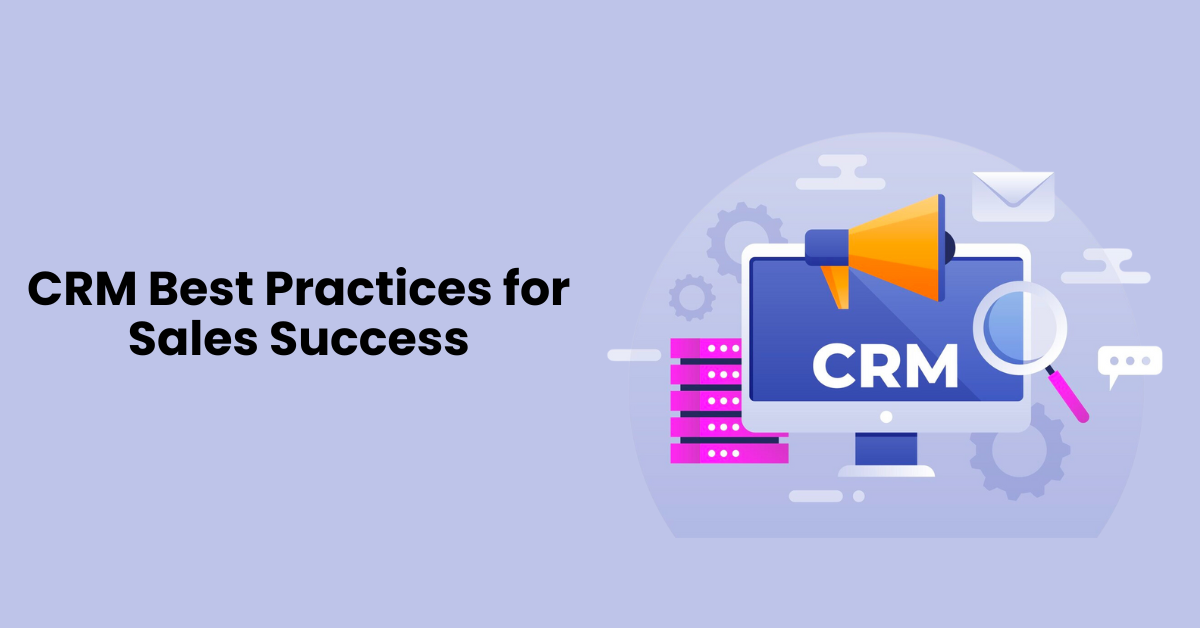CRM Best Practices for Sales Success

In the dynamic and competitive world of sales, success hinges on building strong customer relationships. In today's data-driven landscape, Customer Relationship Management (CRM) software has emerged as an indispensable tool for sales professionals, empowering them to effectively manage customer interactions, nurture leads, and drive sales growth.
CRM systems, when implemented effectively, can transform sales processes, enhance customer satisfaction, and ultimately boost sales performance. However, realizing the full potential of CRM requires a strategic approach and adherence to best practices.
This blog discusses CRM best practices, providing you with actionable insights to unlock the power of CRM and achieve sales success.
What is CRM?

CRM stands for Customer Relationship Management. It is a strategy and technology that companies use to manage and improve their relationships with current and potential customers. CRM techniques help companies organize customer data, track interactions, and automate tasks so that they can provide better customer service, grow sales, and increase profitability.
What benefits does a business get from CRM?

Customer Relationship Management best practices offer a wide range of benefits to businesses across various industries. Here are some key advantages:
Improved customer relationships
CRM systems help businesses build and maintain stronger relationships with their customers by providing a centralized database of customer information. This includes contact details, communication history, and preferences, enabling more personalized interactions.
Enhanced customer service
Access to a comprehensive customer profile allows customer service teams to better understand customer needs and issues. This leads to faster and more effective problem resolution, improving overall customer satisfaction.
Increased efficiency
CRM systems streamline processes and automate routine tasks, reducing manual data entry and administrative overhead. This allows employees to focus on more value-added activities, ultimately improving productivity.
Sales process optimization
CRM systems provide tools for managing sales leads, opportunities, and pipelines. Sales teams can track interactions, forecast sales, and prioritize leads more effectively, resulting in improved sales performance.
Better communication and collaboration
CRM systems facilitate communication and collaboration among team members by providing a centralized platform for sharing customer information. This ensures that everyone in the organization has access to up-to-date data.
Data centralization
All customer-related data, including contact information, purchase history, and communication records, is stored in a centralized location. This eliminates data silos and ensures that all teams have a unified view of customer information.
Marketing automation
CRM systems often integrate with marketing automation tools, allowing businesses to create targeted marketing campaigns, track campaign effectiveness, and generate leads more efficiently.
Improved analytics and reporting
CRM systems provide robust reporting and analytics features. Businesses can gain insights into customer behavior, sales performance, and overall business trends, enabling data-driven decision-making.
Customer segmentation
With CRM, businesses can segment their customer base based on various criteria such as demographics, buying behavior, or preferences. This enables targeted marketing efforts and personalized communication.
Lead management
CRM systems help businesses track and manage leads throughout the entire sales process. This includes lead generation, qualification, and nurturing, leading to more effective sales conversion.
Forecasting and planning
CRM systems provide tools for sales forecasting, allowing businesses to make informed predictions about future sales performance. This aids in resource allocation, inventory planning, and overall business strategy.
Customer retention
By understanding customer preferences and needs, businesses can implement strategies to improve customer loyalty and retention. CRM systems help identify opportunities for upselling and cross-selling to existing customers.
Scalability
As businesses grow, CRM systems can scale to accommodate increased data and user requirements. This scalability ensures that the CRM solution remains effective as the business expands.
Compliance and security
CRM systems often include features to help businesses comply with data protection regulations. They also provide security measures to safeguard sensitive customer information.
Customer relationship management best practices
Implementing CRM data best practices is essential for maximizing the effectiveness of your CRM system and fostering strong, long-lasting relationships with customers. Here are the list of some CRM best practices:
Define clear objectives
Clearly outline your goals and objectives for implementing a CRM system. Whether it's improving customer satisfaction, increasing sales, or streamlining processes, having well-defined objectives will guide your CRM strategy.
Customer-centric approach
Focus on the needs and preferences of your customers. Use CRM to gather and leverage customer data for personalized interactions, tailored marketing campaigns, and better overall customer experiences.
Train Your team
Provide comprehensive training to your team on how to use the CRM system effectively. Ensure that all users understand the features and functionalities that are relevant to their roles.
Data quality
Maintain accurate and up-to-date customer data. Regularly clean and update your CRM database to eliminate duplicates, errors, and outdated information. Accurate data is crucial for making informed business decisions.
Encourage user adoption
Encourage and incentivize your team to use the CRM system consistently. Address any concerns or challenges they may face and emphasize the benefits of accurate data and streamlined processes.
Integration with other systems
Integrate your CRM system with other business systems, such as marketing automation, e-commerce, and customer support platforms. This ensures a seamless flow of information across the organization.
Segmentation and targeting
Utilize CRM data to segment your customer base. Tailor your marketing efforts and communication strategies based on customer segments to increase relevance and engagement.
Automate repetitive tasks
Implement automation for routine and repetitive tasks, such as data entry, lead scoring, and follow-up emails. Automation saves time and reduces the risk of human error.
Customer communication
Use CRM to facilitate consistent and personalized communication with customers. Track interactions, monitor communication history, and ensure that all team members have access to the latest information.
Feedback and monitoring
Encourage feedback from users and regularly monitor CRM performance. Use analytics to measure the effectiveness of your CRM strategy and identify areas for improvement.
Security measures
Implement robust security measures to protect customer data. Restrict access to sensitive information based on user roles and regularly review and update security protocols.
Scalability
Choose a CRM system that can scale with your business. Ensure that the CRM solution can accommodate growing data volumes, user numbers, and additional features as your business expands.
Regular system audits
Conduct regular audits of your CRM system to identify and address any issues. This includes data accuracy checks, system performance assessments, and user activity reviews.
Continuous improvement
CRM is not a one-time implementation; it's an ongoing process. Regularly review and update your CRM strategy to align with changing business needs, customer expectations, and technological advancements.
CRM best practices examples
Here are some CRM activities examples with brief explanations:
Customer segmentation
Best Practice: Segment your customer database based on various criteria such as demographics, purchasing behavior, and engagement levels.
Example: A retail business might segment customers into categories like frequent shoppers, seasonal buyers, and one-time purchasers.
Personalized communication
Best Practice: Use CRM data to personalize communication, addressing customers by name and tailoring content to their preferences.
Example: An e-commerce company sends personalized product recommendations based on the customer's past purchases and browsing history.
Lead scoring
Best Practice: Implement lead scoring to prioritize leads based on their likelihood to convert.
Example: A B2B company assigns higher scores to leads that have engaged with multiple pieces of content or attended webinars.
Automation for efficiency
Best Practice: Implement automation for repetitive tasks such as data entry, lead nurturing, and follow-up emails.
Example: An insurance company uses automation to send policy renewal reminders to customers based on their policy expiration dates.
360-degree customer view
Best Practice: Maintain a comprehensive customer profile that includes interactions from various touchpoints.
Example: A hospitality business tracks a customer's reservations, preferences, and feedback to create a holistic view of their experience.
Integration with marketing
Best Practice: Integrate CRM with marketing automation tools for seamless coordination between sales and marketing efforts.
Example: A software company uses CRM data to trigger targeted email campaigns based on a customer's stage in the sales funnel.
Conclusion
Embracing Customer Relationship Management (CRM) as a central tool empowers sales professionals to effectively manage customer interactions, nurture leads, and accelerate sales cycles, leading to remarkable success.
By adopting these best practices and continuously refining your CRM strategy, you can empower your sales team to achieve remarkable success and propel your business to new heights. Imagine a world where sales professionals are armed with the insights and tools they need to cultivate lasting customer relationships, convert leads into loyal customers, and drive business growth to unprecedented levels. That's the power of CRM done right.

.png)
